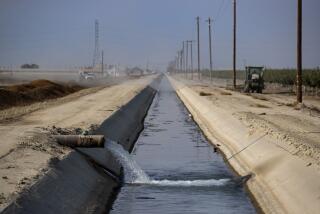Sprawl Adds to Drought, Study Says
- Share via
WASHINGTON — The rapid expansion of paved-over and developed land in metropolitan areas has made already intense drought conditions even worse, a report released Wednesday says.
Water that used to seep into fields or grasslands now rushes off new roads, roofs, driveways and parking lots, turning into polluted runoff.
“Sprawl development is literally sending billions of gallons of badly needed water down the drain each year--the storm drain,” said Betsy Otto, senior director for watershed programs at American Rivers, a national environmental organization.
“Sprawl hasn’t caused this year’s drought, but sprawl is making water supply problems worse in many cities.”
In Atlanta and its surrounding counties--where more than 609,000 acres were developed between 1982 and 1997--development is sending 57 billion to 133 billion gallons of polluted runoff into streams and rivers each year, according to the report, prepared by American Rivers; the Natural Resources Defense Council, another national environmental organization; and Smart Growth America, a group dedicated to sustainable development.
This water--which the report says could support the average annual household needs of between 1.5 million and 3.6 million people--would otherwise be filtered through the soil to recharge aquifers and provide underground flows to replenish rivers, streams and lakes.
Some government scientists said they agreed with some of the report’s general conclusions, such as that urbanization increases runoff and reduces the recharging of ground water. But they questioned the scientific rigor behind the computations.
“They’re portraying them as very dramatic; I would be skeptical that they’re so dramatic,” said William Alley, chief of the U.S. Geological Survey’s office of ground water.
“Because you have a simple rule of thumb--you pave an area, you reduce infiltration--you cannot immediately take license to quantify it,” added Harry Lins, the agency’s drought science coordinator.
The authors of the report, which studied the effects of development on water supplies in 18 rapidly growing metropolitan areas, said they were not trying to come up with precise numbers for any region, but wanted to show the magnitude of the problem.
They urged the Geological Survey to embark on a thorough scientific study.
Other drought experts said they had no doubt that rapid development was exacerbating water shortages during the current drought, but they agreed that the extent was impossible to quantify. About 40% of the country is suffering through a moderate or severe drought, with the most extreme conditions along much of the East Coast and in the Southwest.
“It is a contributing factor,” said Mark Svoboda, a climatologist at the National Drought Mitigation Center, an independent institute based at the University of Nebraska and funded by the U.S. Agriculture Department.
The model used in the study to compute the loss of ground-water infiltration does not apply to Southern California and other arid regions, where rainfall evaporates quickly and much of the drinking water comes from snowmelt hundreds of miles away, the report’s authors said.
Otto said she could not say whether Southern California’s sprawl would have a parallel effect on water supplies.
Scientists explained that covering the ground with impervious surfaces, such as roads and buildings, increases runoff and decreases the reabsorption of rainwater.
This reabsorption is particularly important to streams and lakes during a drought, because ground water can seep into depleted bodies of water.
“The primary effect would be on stream flow,” Alley said. “Essentially, the recharge is working its way through ground water. It sustains streams through very dry periods.”
The report’s authors said the problem can be mitigated if future development is concentrated in areas where people already live, new road building is curtailed and open spaces--such as farms and forests--are preserved. They also urged the adoption of new techniques that would facilitate the absorption of storm water.
“By investing wisely in places we live, we can both protect our environment and improve our quality of life,” said John Bailey, associate director of Smart Growth America.
Local, state and federal governments have a role to play in reversing the trend, the authors said, because a whole range of government spending, regulations, subsidies, taxes and policies now stimulate sprawl by making development outside urban centers cheaper and easier than building within cities.
The construction industry criticized the report, calling it a blatant effort by the environmental groups to support their goal of increasing regulations on development.
“Water is a zero-sum game,” said Clayton Traylor, a senior vice president of the National Assn. of Home Builders.
“You move it from one place to another; it doesn’t actually disappear.”
Traylor said the report takes too much of a leap by concluding that the increase in runoff depletes water supplies and worsens the current drought.
Modern developments use “extremely sophisticated” strategies to contain the water and avoid the traditional perils of runoff, he said.
*
(BEGIN TEXT OF INFOBOX)
More Cement, Less Water
When undeveloped land is paved, water that would normally filter into the ground and refresh aquifers instead runs into streams and rivers. Estimated loss of ground water in some of the top land-consuming metropolitan areas:
Acres developed Average yearly 1982-1997 infiltration loss
Atlanta 609,500 56.9 to 132.8
Boston 433,000 43.9 to 102.5
Charlotte, N.C. 246,200 13.5 to 31.5
Chicago 250,000 10.2 to 23.7
Dallas 302,400 6.2 to 14.4
Detroit 187,200 7.8 to 18.2
Greensboro, N.C. 148,100 6.7 to 15.7
Greenville, S.C. 166,300 12.7 to 29.5
Houston 291,400 12.8 to 29.8
Minneapolis 286,100 9.0 to 21.1
Nashville 216,000 17.3 to 40.5
Orlando, Fla. 222,600 9.2 to 21.5
Philadelphia 238,800 25.3 to 59.0
Pittsburgh 201,800 13.5 to 31.5
Raleigh-Durham, N.C. 207,000 9.4 to 21.9
Seattle 141,000 10.5 to 24.6
Tampa, Fla. 199,800 7.3 to 17.0
Washington, D.C. 343,300 23.8 to 55.6
Source: American Rivers
*In billions of gallons of water






